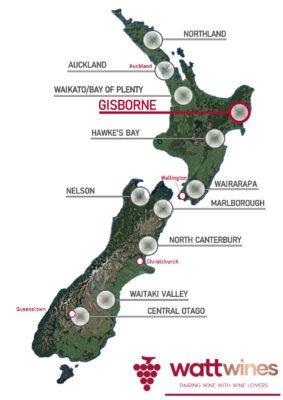Nestled on the easternmost coast of New Zealand’s North Island, Gisborne is the country’s first region to greet the sunrise. Known for its stunning coastline and fertile plains, Gisborne is a haven for winemakers and wine enthusiasts alike.
Gisborne is 470 km from Auckland and 530 km from Wellington. It is home to boutique wineries and large producers. The region is rich in history and lays claim to being Captain Cook’s first landfall. Wine production in Gisborne dates back to the late 19th century, with early European settlers recognizing the region’s potential for viticulture.
The region enjoys a warm, sunny maritime climate, perfect for grape growing. Average temperatures range between 19°C and 24°C, and the area receives around 1,000-1,200 mm annually. The growing season is long and sunny, with cool nights that help preserve acidity in the grapes, ensuring balanced and vibrant wines.
Known as the Chardonnay Capital of New Zealand, Gisborne has historically focused on producing premium white wines. In recent decades, winemakers have diversified, crafting aromatic wines like Gewürztraminer, Viognier, and some natural wines.
The region has four distinct subregions. Ormond is north of the city, where the river valley narrows into the Raukumara Ranges. This area is home to ‘The Golden Slope’, a 10km gently-sloping, free-draining escarpment with limestone-influenced topsoil, which produces some of Gisborne’s best Chardonnay.
Patutahi is further south and around one-third of region’s vines are found on this warmer inland site, to the west of the city. With low rainfall and well-draining, sloping clay and silt soils this area produces excellent, rich Gewürztraminer, along with other varieties, with good texture and body. Central Valley sites between these two subregions.
Manutuke is a coastal area south of the city. Vines were first established in the late 1890s. Chardonnay is the main variety grown in well-drained and sandy soils, with silty and heavier Kaiti clay soils found in sites to the hillier west. Nearer to the river, soil and climatic conditions can produce delightful botrytised wines and finely textured aromatics.
The region offers a great wine trail that combines boutique wineries, scenic coastlines, and stunning vineyard views, making it a top destination for wine tourism. In addition to wines, the region is a rich tapestry of Māori culture and history, often celebrated in local wine festivals and events.
Not only is Gisborne the first wine region in New Zealand to see the sun, but it is the first wine region in the world to experience each new day.
Top Stats
Harvest
End Feb to mid Apr
Mean Jan temperature
22°C
Area of Vine
1,276 hectares
Altitude
0-200m
Annual rainfall
1,000-1,200 mm
Principal Varietals
Gisborne is famously known as the Chardonnay Capital of New Zealand. This varietal thrives in the region’s sunny climate and fertile soils, producing a range of styles from bright and citrusy to rich and oaky. Depending on the winemaking approach, expect flavours of stone fruit and citrus and subtle notes of butter or vanilla. In 2024, 582 hectares were under planting.
Pinot Gris is a versatile and popular varietal in the region. Gisborne’s Pinot Gris is known for its ripe pear, apple, and stonefruit flavours. The region’s sunny days and cool nights give this wine a delightful balance of fruitiness and freshness, making it a crowd-pleasing choice for many occasions. In 2024, 288 hectares were underplanting.
While not as dominant as regions like Marlborough, Sauvignon Blanc offers a distinctive, softer style. The warmer climate contributes to ripe tropical fruit flavours such as passionfruit, pineapple, and guava, complemented by hints of citrus and a gentle herbaceous character. The wines tend to have a rounder mouthfeel and a more restrained acidity, making them approachable and food-friendly. In 2024, 250 hectares were underplanting.
Gisborne’s warm climate and fertile soils create conditions ideal for ripening Merlot, resulting in smooth, fruit-forward wines with soft tannins. The region’s Merlots are often lush and approachable, showcasing flavours of ripe plum, blackberries, and hints of chocolate or spice. While Merlot production in Gisborne is smaller than in Hawke’s Bay, it continues to grow in quality and recognition. In 2024, 24 hectares were underplanting.
Aromatic and exotic, Gisborne’s Gewürztraminer is a standout, offering a rich bouquet of lychee, rose petals, and spices. The region’s warm climate helps develop its lush, tropical flavours while maintaining balanced acidity, creating an opulent and refreshing wine. In 2024, 19 hectares were underplanting.
Source: www.nzwine.com,








